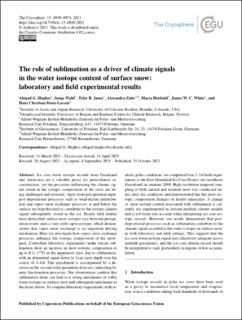| dc.contributor.author | Hughes, Abigail G. | |
| dc.contributor.author | Wahl, Sonja | |
| dc.contributor.author | Jones, Tyler R. | |
| dc.contributor.author | Zuhr, Alexandra | |
| dc.contributor.author | Hörhold, Maria | |
| dc.contributor.author | White, James W. C. | |
| dc.contributor.author | Steen-Larsen, Hans Christian | |
| dc.date.accessioned | 2022-04-05T08:26:20Z | |
| dc.date.available | 2022-04-05T08:26:20Z | |
| dc.date.created | 2021-11-10T15:34:52Z | |
| dc.date.issued | 2021 | |
| dc.identifier.issn | 1994-0416 | |
| dc.identifier.uri | https://hdl.handle.net/11250/2989820 | |
| dc.description.abstract | Ice core water isotope records from Greenland and Antarctica are a valuable proxy for paleoclimate reconstruction, yet the processes influencing the climate signal stored in the isotopic composition of the snow are being challenged and revisited. Apart from precipitation input, post-depositional processes such as wind-driven redistribution and vapor–snow exchange processes at and below the surface are hypothesized to contribute to the isotope climate signal subsequently stored in the ice. Recent field studies have shown that surface snow isotopes vary between precipitation events and co-vary with vapor isotopes, which demonstrates that vapor–snow exchange is an important driving mechanism. Here we investigate how vapor–snow exchange processes influence the isotopic composition of the snowpack. Controlled laboratory experiments under forced sublimation show an increase in snow isotopic composition of up to 8 ‰ δ18O in the uppermost layer due to sublimation, with an attenuated signal down to 3 cm snow depth over the course of 4–6 d. This enrichment is accompanied by a decrease in the second-order parameter d-excess, indicating kinetic fractionation processes. Our observations confirm that sublimation alone can lead to a strong enrichment of stable water isotopes in surface snow and subsequent enrichment in the layers below. To compare laboratory experiments with realistic polar conditions, we completed four 2–3 d field experiments at the East Greenland Ice Core Project site (northeast Greenland) in summer 2019. High-resolution temporal sampling of both natural and isolated snow was conducted under clear-sky conditions and demonstrated that the snow isotopic composition changes on hourly timescales. A change of snow isotope content associated with sublimation is currently not implemented in isotope-enabled climate models and is not taken into account when interpreting ice core isotopic records. However, our results demonstrate that post-depositional processes such as sublimation contribute to the climate signal recorded in the water isotopes in surface snow, in both laboratory and field settings. This suggests that the ice core water isotope signal may effectively integrate across multiple parameters, and the ice core climate record should be interpreted as such, particularly in regions of low accumulation. | en_US |
| dc.language.iso | eng | en_US |
| dc.publisher | Copernicus Publications | en_US |
| dc.rights | Navngivelse 4.0 Internasjonal | * |
| dc.rights.uri | http://creativecommons.org/licenses/by/4.0/deed.no | * |
| dc.title | The role of sublimation as a driver of climate signals in the water isotope content of surface snow: Laboratory and field experimental results | en_US |
| dc.type | Journal article | en_US |
| dc.type | Peer reviewed | en_US |
| dc.description.version | publishedVersion | en_US |
| dc.rights.holder | Copyright 2021 The Author(s) | en_US |
| cristin.ispublished | true | |
| cristin.fulltext | original | |
| cristin.qualitycode | 2 | |
| dc.identifier.doi | 10.5194/tc-15-4949-2021 | |
| dc.identifier.cristin | 1953319 | |
| dc.source.journal | The Cryosphere | en_US |
| dc.source.pagenumber | 4949-4974 | en_US |
| dc.relation.project | ERC-European Research Council: 759526 | en_US |
| dc.identifier.citation | The Cryosphere. 2021, 15 (10), 4949-4974. | en_US |
| dc.source.volume | 15 | en_US |
| dc.source.issue | 10 | en_US |

